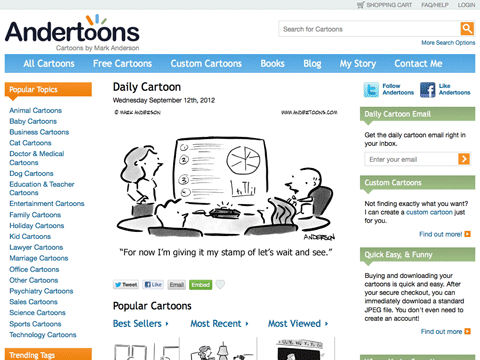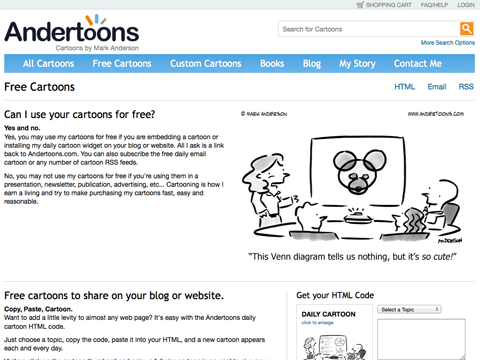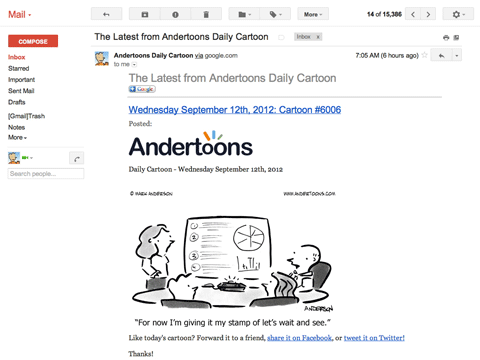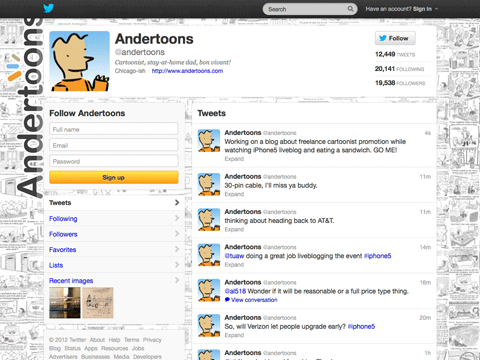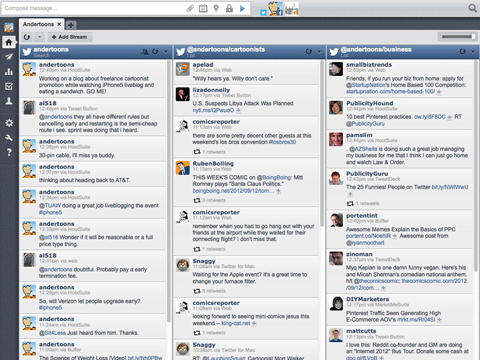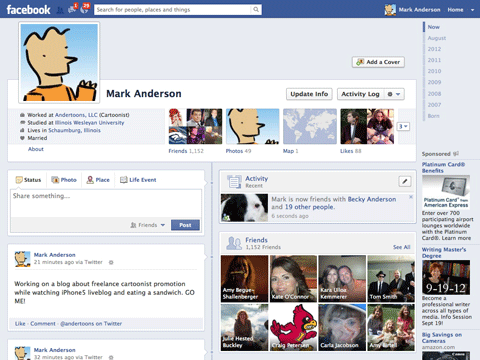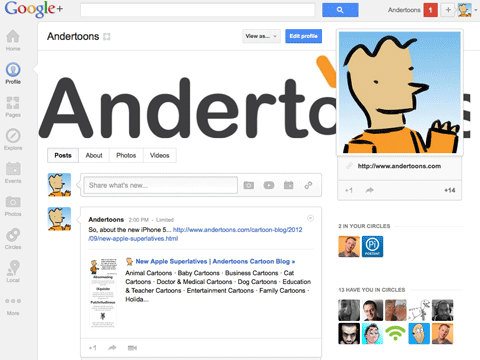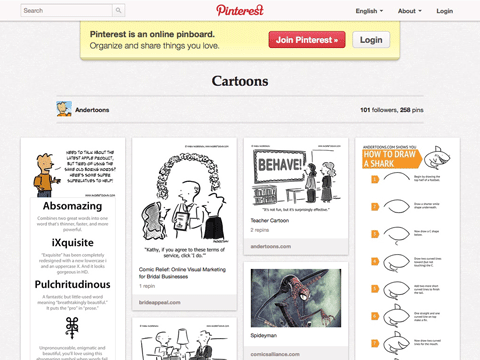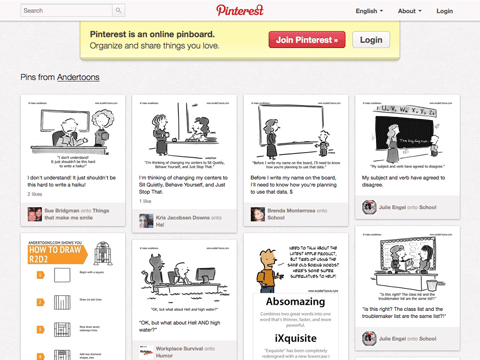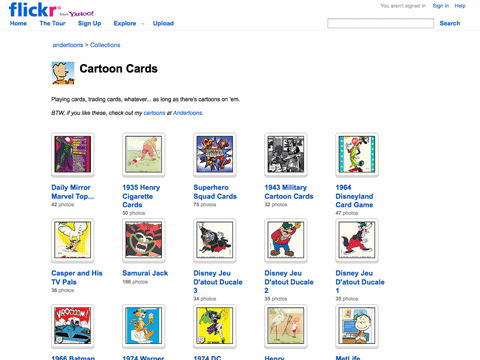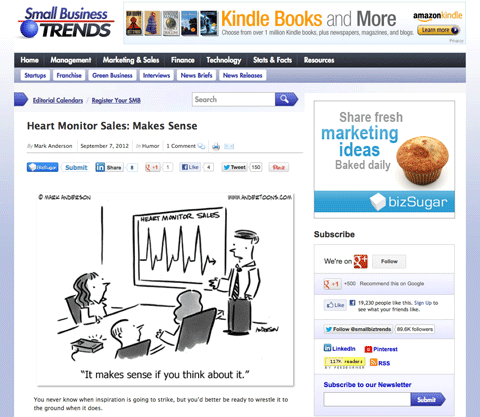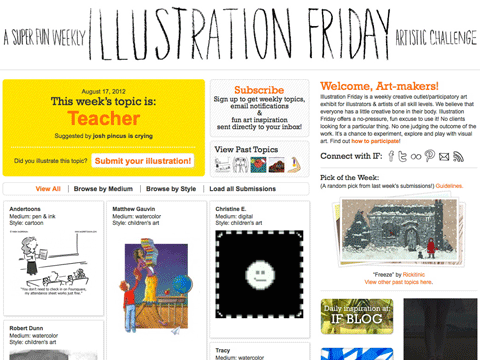Video transcript:
Hi there, this is Mark Anderson from Andertoons.com and today I am going to be showing you how I sketch and re-sketch and then ink a cartoon. What’s different this time, I have done a number of videos where I have drawn a business cartoon or a family scene, some sort of cartoon scene that I am used to drawing because of course I want to put my best foot forward there on the video and look like I know what I am doing, but I thought it would be interesting this time to draw a scene for you that I haven’t drawn before. It’s an idea that I got when I was at a bank recently and although it doesn’t look like that now, it’ll make more sense later and I’ll explain to you why I got the idea, but it’s a–I am going to be drawing a guy here in bed who has died and then a grim reaper and a ghost. But this isn’t a scene that I’ve necessarily done before so I am just sort of winging it here and doing a very rough sketch to lay things out.
So there is the guy and he is laying in bed now I’ve sort of got to the angle of the scene roughed in, there is the pillow and I am keeping this very, very rough and very loose and trying to go fast and you know keep it lively. So you are going to see lots of sketchy lines and things that aren’t going to make it into the final art of course. But it’s just the way–see there I drew it like a head where I wanted it and then I decided I didn’t want it there. Now it looks like I am changing something again I don’t quite know am I putting–I’ve recorded this voice over later so it’s been a couple of weeks since I drew this, so I am sort of watching along as you go here, sort of like a director’s cut of the cartoon.
Oh here is the ghost, here’s like the idea of the ghost coming out of the guy, I am sort of drawing it over there and there is his ghostly arms and there’s he is coming out of the chest of the old man laying in the bed. Yeah I’ve abandoned–I abandoned that head over to the upper right of him. Here comes the grim reaper, again I just started with real basic shapes, he’s you know the grim reaper sort of this hooded shrouded figure, so I start with this circle for the head and a triangle sort of over it and a wavy line to make the robe. So very, very basic kinds of shapes and lines and I am just moving fast and I am not worrying about making mistakes and as I go the things that I like I tend of reinforce or draw darker or yeah to go over the line again. Oh here I am sort of going back and this guy and adding a few hairs in and this mouth I sort of jump back and forth.
I am not sure if there is any rhyme or reason necessarily, it’s just sort of letting my self go. So there is the grim reaper, now I am drawing his, is that a sickle is it? No it’s a–oh I am never going to pronounce this right I got myself into recording. Is it a scythe? Is that how you say that? Is that the correct term for that? Wow you know what I should’ve looked at it out before recording this. Note to self – If there is an important part of the cartoon and you don’t know how to pronounce it, look it up before recording the voice over for the video.
So here is my the rough, rough sketch and what I am going to do now is take this and why am I signing my rough sketch? I am going take this and I am going to trace over using my light desk. Those are good transition, nice job iMovie. So there I’ve got the rough sketch under a clean sheet of paper and I am taking my pencil here and I am redoing, going over those lines and again I am trying to keep it fast and fluid but I am sort of giving myself a cleaned up sketch to do the ink off of.
So I’ve got the basic idea of the cartoon there and I am just going to clean it up so when that I ink it’s the best possible version of this cartoon. So there is a lot of–I do a lot of editing and a lot of redrawing cartoons, there is my first sketch and often times it takes more than one clean up sketch. Sometimes I do 2, 3, 4, if I started to get into like the 3rd or 4th sketch I know that something is wrong and I then need to start over or figure out how to draw what I need to draw and take another look at it, so generally its that first rough sketch and then the next sketch and then I move on to ink after that.
So here’s our grim reaper, he is looking pretty good. He is a–he is going to be talking to the ghost here you can see it, oh it looks nice. Then I’ll be drawing the ghost in here. When I do the ink for this what I will do is draw the ghost separately from the rest of the cartoon and then when I scan it in I’ll scan in the grim reaper at the bed with the dead man and then I’ll also scan in the ghost and I’ll put the ghost in on another layer in Photoshop because I want to change the opacity there and have him appear like he is–this transparent or you know translucent ghost over the scene and that was something that I sort of thought of when I did this and thought that it would be fun to do so, here is my clean up sketch, that’s looking pretty nice that’s all right. Okay nice job me.
Re-focusing the camera there it’s looking pretty good. I am not drawing a lot of background in here. Oh see now there I go, I am just I didn’t like the little wave on of his ghosty body so I am sort of going over and redoing the arms again giving his head a little bit more of a squiggle so that he appears more ghostly and I apparently did not like the shape of the hood on this grim reaper. But yeah that’s looking pretty good. Am I doing another sketch? Like I said it’s been a while so I am doing another sketch. Wow! Remember that thing I told you like if I get to go the 3rd or 4th sketch I really need to take it a–yep I am doing another one. Here I go, look at me go. I am redoing this one, I want to get this one right apparently.
I am recording this on September 12th but I actually did this cartoon – I drew this cartoon on August 1st, so it’s about a month and a half later so I apologize for my apparent confusion over what I am actually doing here but that’s why it’s much later after I drew it. So I am on the third sketch here drawing my ghost coming out of the dead guy and the grim reaper will be talking to him, so now I’m getting that and again I am doing little the other hand a little squiggle to make his legs and feet and things in the bed.
You know by the time we get to a third sketch like this you just really start to worry a bit like, oh boy, you know, how bad is this going to be, how dead is this going to be on the page, so I am a little worried now rewatching that this cartoon is just going to lie there but I seem to remember that it turned out pretty nicely. I looked at it real quick before I started putting this video together and it turned out all right.
So again the thing that I tried to keep in mind is just to move fast–wow! You can’t see anything there, look at that giant hand! I just try to keep moving fast and loose and not be too careful. There is nothing worse than a cartoon that just looks like it’s just going to lay there. You really want this to pop and so I am not worried about getting the exact squiggle on the hood right you know, oh it goes up here and down here its just a nice little squiggly line and there it is. All right so there is the third and boy I hope it’s a final, I didn’t watch this before I started recording, obviously now I am–am I going to sign it again? Looks like neat little pencil trick there. That actually looked impressive. I think I’ve–oh okay, I like to put a box around the sketch so that I can sort of see like where I need to stop and start and stop drawing for the ink so its sort of like putting a frame around it so that I know I don’t need to go below here and I am writing myself a little note, I do this all the time. Yep I there right there I was like hmm–I think I’ll do that separately and do that in Photoshop.
So here I am doing the ink, I am sorry for the length of this; it looks like we are going to clock in at just about 15 minutes which I thought was long. When I looked at it I was like wow, it never takes me that long to do it, it’s that there its got that’s the time burglar that third sketch, but it all turned out for the best and when you think about it 15 minutes versus 10 minutes in the grand scheme of things to get a cartoon right, I will make that time investment I will add another 5 minutes to my work day to get this dead guy cartoon right. So now I am inking and give you a little bit more of a closer appearance so you can see that. I love these brush pens boy they are just so nice; they move so nicely on a page I keep think one of these days I am going to move to that Wacom that Cintiq is that what it is? Is that how you pronounce that? Another word I don’t know how to pronounce but that one’s made up so it doesn’t count. I keep thinking one of these days I am going to move to going all digital but boy I just can’t, I am not there I love that feel of pen and that ink on paper and just the way that it sits, there is just a good feel, I don’t know that I could get that, I know a lot of people do it and are really happy with it and I moved all my shading to Photoshop but boy I don’t know that I could ever give up like the ink and paper aspect of it, I just wouldn’t feel good about it.
Change something with the lights, lights there may be I just changed the focus on the camera. I have got a–I am doing this on a light desk and then sometimes I’ll also turn on my desk lamp depending on like how much I want to see it. So sometimes I have got light coming up from underneath and on top, like I said depending on how much of what I want to see for tracing or inking or penciling. I am not ashamed to have a whole bunch of lights and I’ll put more lights on if I think I need it I would do that. Here is the sleeve, its looking pretty nice, I put an arrow there, what is that arrow for? I made some sort of mistake I don’t remember what now; oh I bet it’s for the little crinkle in his elbow I don’t think that turned out very well. I bet that’s what I put that there for. Take that out in Photoshop.
So now see here I am taking the pieces of paper apart and you get to see it, oh! Oh yeah you don’t miss a thing I don’t know, at this umm…hmm…no, no, you dear viewer get to see every little bit, me repositioning things, taping things. May be I’ll go get a soda you get–it’s unvarnished. I am doing the ghost just a little bit up above there and here comes the ink. I am trying to keep it nice and wavy and I am not worried about little gaps between lines, I am not going to worry about making sure that everything is tightly closed up I don’t–its just not my style, I don’t but there is so many artists that I was influenced by but the ones that I always like to have that really loose style and they didn’t connect all the lines and I just always love the way that looked.
So I am finishing up the ink on this, there is the ghost floating above and I am writing another little note there to put that down and skin those in separately and put that over that in Photoshop and looks like I am going to be up there. Here comes signature and this cartoon is up on my website now, I believe what is the number of this cartoon? I need to get organized before I recorded these things. Anyway here is the final version of the cartoon, “If you are as satisfied with my service please take a moment to fill out the survey.” Guy said this to me at the bank and I thought I know there is a cartoon there. So thanks for watching and be sure to visit Andertoons.com.

